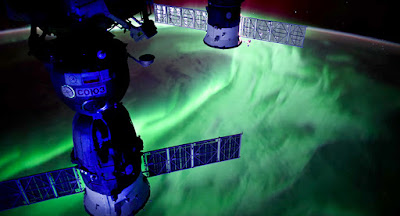 |
| An aurora viewed from the International Space Station. Credit: NASA |
Auroras have long dazzled sky watchers but befuddled physicists. Via a mechanism that remains unclear, electrons get yanked away from the magnetosphere and slammed into the ionosphere, where their collisions with atoms and molecules engender green, red, and blue light. (See the Quick Study by Bob Strangeway, Physics Today, July 2008, page 68.) The leading culprits for scooping up and accelerating auroral electrons are Alfvén waves, oscillations of the ions in a plasma that propagate along magnetic field lines. The oscillations can be triggered by magnetic storms, which often portend auroral displays. And at least in theory, the waves should be able to propel electrons in their path.
Auroras: The sun sends us more than heat and light; it sends lots of other energy and small particles our way. The protective magnetic field around Earth shields us from most of the energy and particles, and we don’t even notice them.
But the sun doesn’t send the same amount of energy all the time. There is a constant streaming solar wind and there are also solar storms. During one kind of solar storm called a coronal mass ejection, the sun burps out a huge bubble of electrified gas that can travel through space at high speeds. Source: NASA
Alfvén waves: In plasma physics, an Alfvén wave, named after Hannes Alfvén, is a type of magnetohydrodynamic wave in which ions oscillate in response to a restoring force provided by an effective tension on the magnetic field lines. Wikipedia
Physics Today: A step toward deciphering auroras, Andrew Grant
Comments